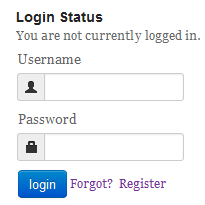The WP-Members recommended WP Setting is to set RSS to summary. But if your site doesn’t need to have an RSS feed (such as a static site using only pages, or if you simply do not promote via RSS), it might be advantageous to turn of RSS. Then that is one less thing you have to worry about protecting. Here is how you can turn off RSS feeds for your site altogether. Continue Reading →
Bootstrap sidebar login example for non-Bootstrap themes
 There is a lot of interest in the sidebar login shown on this site, even by users who may not be using a Twitter Bootstrap theme. The tutorial in the “How I Did It” category is specific to Twitter Bootstrap, which this particular site uses. But this tutorial is an example of how you can create this type of login wiget styling without using a theme based on Twitter Bootstrap. Actually, you will be using Bootstrap or some of it, but loading it with your existing theme and/or custom WP-Members custom css. For this example, we will create this with a simple theme – WordPress TwentyTen. Continue Reading →
There is a lot of interest in the sidebar login shown on this site, even by users who may not be using a Twitter Bootstrap theme. The tutorial in the “How I Did It” category is specific to Twitter Bootstrap, which this particular site uses. But this tutorial is an example of how you can create this type of login wiget styling without using a theme based on Twitter Bootstrap. Actually, you will be using Bootstrap or some of it, but loading it with your existing theme and/or custom WP-Members custom css. For this example, we will create this with a simple theme – WordPress TwentyTen. Continue Reading →
The functions.php file
The functions.php file is an important element in customizing WordPress. It is also an important element in terms of customizing and integrating WP-Members into your site.
While you are not required to do any customization to get WP-Members to work on your site (it is, after all, a plugin), to leverage the power of the framework and thus make it look professional and seamless on your site, you will need to have some knowledge of the functions.php file.
Continue Reading →WordPress site management best practices
WordPress is a great tool and it has become an icon in the Internet world. But with success of distribution comes the vulnerability of becoming a target for hackers. Many of you have experienced what it is like to deal with hacking and malware. Hopefully most of you haven’t experienced this yet. This post will cover some best practices so that hopefully, you won’t ever have to deal with that. Continue Reading →
Blocking content in a custom template
Lately, this question has come up a lot. How do you block content that is outside the loop and still display the login/registration forms on the page.
This type of issue may come up if you are using a custom query to put some specific content on a specific page, or it might be that you are displaying specific data that you want to protect. As long as it is something in the WordPress template framework, you can still use WP-Members to block the content. Continue Reading →